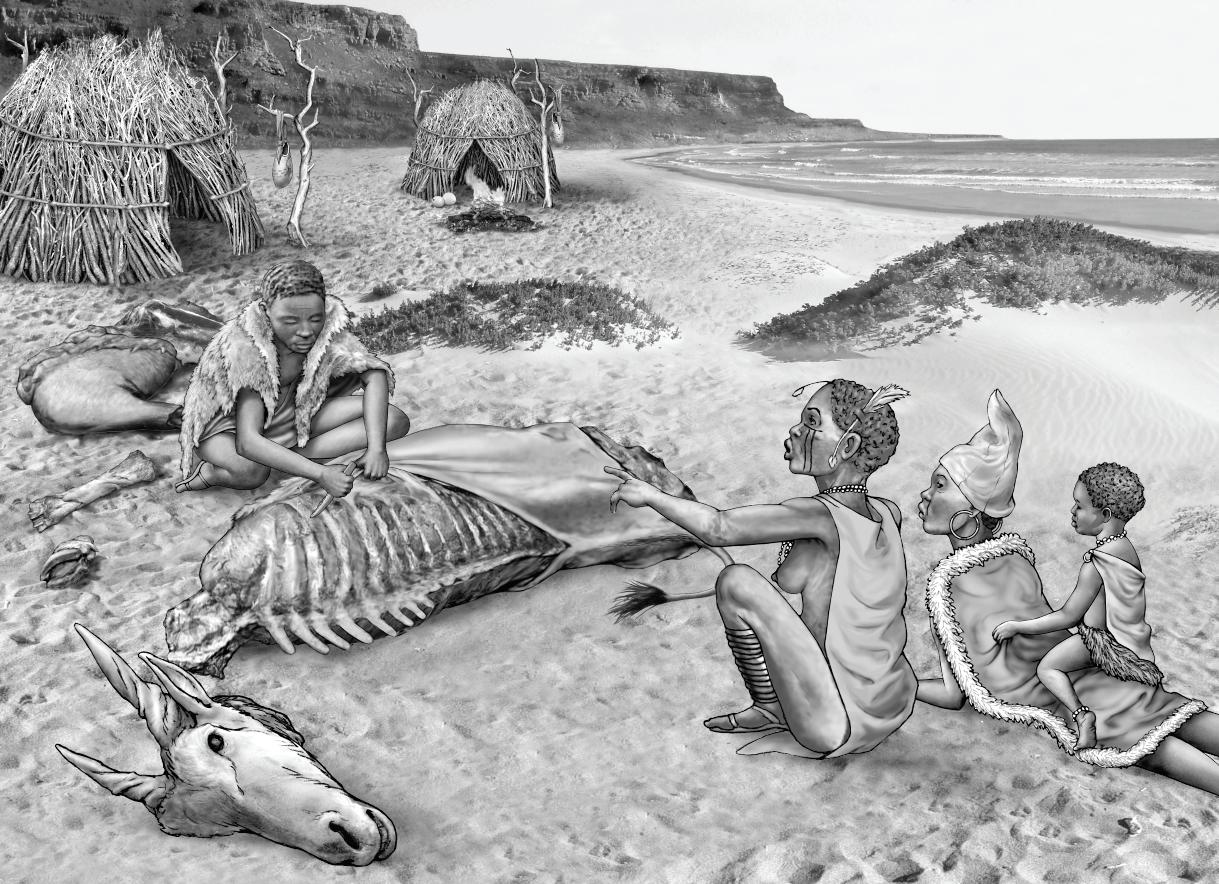
16 minute read
News from the field 2021
from Fall 2021
In spite of the pandemic, UMMAA students and faculty were able to advance their research. Included here is news on their 2021 work in various regions of the world.
Africa
Advertisement
With the pandemic precluding fieldwork in Africa, Museum curator Brian Stewart focused his year on research and writing, as well as teaching and mentoring. His new book manuscript was submitted and is currently in review; entitled A Foraging Nexus: Space, Subsistence and Society at Dunefield Midden, Stewart’s book is a spatial study of site formation, sociality, and ritual life at a well-preserved hunter-gatherer campsite in coastal South Africa. Other outputs this year included articles in the Proceedings of the National Academy of Sciences and Quaternary Research, both co-authored with graduate student Yuchao Zhao. Brian also edited a special issue of the journal Quaternary International, to which he contributed another article with graduate student Kyra Pazan.
Prehistoric coastal foragers butchering an eland at Dunefield Midden on South Africa’s west coast. The pointing woman is offering advice on what should be shared with whom. John Klausmeyer, former illustrator at UMMAA, created this and several other reconstructions of daily life at the site for Museum curator Brian Stewart’s forthcoming book.
Asia
Curator Alicia Ventresca Miller started a new project entitled Centering the Northern Realms: Integrating histories and archaeologies of the Mongol Empire (1200 to 1500 CE). Funded by the Humanities Collaboratory at the University of Michigan, Alicia and her co-PI (Christian de Pee, History Department) are investigating the Northern Realms during the Mongol Empire by integrating histories and archaeologies. Their collaborative research challenges existing descriptions of the northern people of the forest as minor participants in the Mongol Empire. They are finding that power was concentrated in the north, with elites engaging in religious pluralism, controlling rare resources, and affecting Mongol politics. Northern communities were highly influential in networks of exchange, bearing clothing of imported silk and fur while wearing jeweled rings and gold ornaments. The aim of the project is to broaden our understanding of power in the Mongol Empire by demonstrating the central role of the northern realms. They will publish their results, hold seminars, and prepare a comic book and exhibit.
In addition, Alicia had two major publications come out this year: “Re-evaluating Scythian nomadism: Isotopic analysis of diet and mobility in Iron Age Ukraine,” in the journal PLOS ONE, and “Dairying enabled Early Bronze Age Yamnaya steppe expansions,” in Nature. Both publications got a fair amount of press.
Read the press releases: https://www.shh.mpg.de/2045776/milk-and-migration https://www.shh.mpg.de/1968873/miller-scythian-people
And examples of media coverage: https://gizmodo.com/long-known-as-nomads-scythiansmay-have-been-solidly-s-1846448929 https://www.mpg.de/17544984/milk-enabled-massivesteppe-migration https://www.science.org/content/article/milk-fueledbronze-age-expansion-eastern-cowboys-europe?utm_ campaign=NewsfromScience&utm_source=Social&utm_ medium=Twitter&
Right: Museum curator Alicia Ventresca Miller works in the paleoproteomics lab at the Max Planck Institute for the Science of Human History.
Save the Date!
Ancient Protein and Isotope Laboratory opening in spring 2022
In 2022, the University of Michigan Museum of Anthropological Archaeology (UMMAA) will open a new laboratory suite in the Chemistry building, directed by Museum curator Alicia R. Ventresca Miller.
The Ancient Protein Laboratory is a state-of-the-art facility with separate areas for sampling and extraction of proteins. The facility has the potential to extract proteins from a wide variety of archaeological samples, including dental calculus, bone, enamel, and residues from ceramics and tools.
The Isotope Laboratory is a dedicated space for the analysis of archaeological materials, including enamel, bone, dentin, and plants. This facility includes areas for collagen extraction and the preparation of organic samples, and a separate drilling room for sub-sampling of archaeological materials. There will also be a dedicated location for the extraction of proteins and preparation of sample plates for ZooMS.
Methods • Ancient Proteins / Paleoproteomics • Carbon and Oxygen Isotopes of Tooth Enamel • Carbon and Nitrogen Isotopes of Bone Collagen • ZooMS (Zooarchaeology by Mass Spectrometry)

Europe
Museum director Michael Galaty directed fieldwork in Kosova. This was the third field season of intensive archaeological survey and builds upon the first two seasons in 2018 and 2019. The project, called RAPID-K —Regional Archaeology in the Peja and Istog Districts of Kosova—is co-directed by Galaty, Haxhi Mehmetaj (Archaeological Institute of Kosova), and Sylvia Deskaj (University of Michigan). The primary goal of RAPID-K is to locate archaeological sites of all periods in western Kosova on the Dukagjin Plateau and to address changes in settlement patterns through time. In three years the team has discovered 52 new sites. One of these, Pepaj, is a very large Late Bronze Age site (c. 1200 BC). Another, Lluga, is a Late Neolithic village (c. 5000–4500 BC). In 2021, the team conducted geophysical surveys at both sites, led by Apostolos Sarris (University of Cyprus). Lluga is of particular interest: magnetometry identified what may be the remains of several large intact longhouses and a possible enclosure ditch. RAPID-K plans a study season in 2022, followed by publication of the survey results. Largescale excavations will (hopefully) commence in 2024. Several Michigan students participated in RAPID-K 2021, including Gabriella Armstrong, Erina Baci, Matthew
Brown, Zhaneta Gjyshja, Buck Roberson (IPCAA),
Julian Schultz, and Madeline Topor.

In 2021, the RAPID-K crew conducted its third year of intensive archaeological survey of western Kosava. Above: geophysical survey at Pepaj, a very large Late Bronze Age site. Below: the 2021 RAPID-K crew.

In the late spring and summer of 2021, graduate student Györgyi Parditka conducted a significant portion of her dissertation-related data collection in Hungary and Serbia, with support from the Rackham International Research Award. From early May until mid-July Györgyi worked with museum collections at the Móra Ferenc Museum in Szeged, Hungary. She collected ceramic stylistic information for her doctoral dissertation research from three Bronze Age sites.
In the second part of the summer Györgyi visited museum collections at Kikinda, Serbia with fellow graduate student Iride Tomažič. They helped each other in their data collection. In addition to collecting data at the museum, they also visited the Rabe Anka Siget Bronze Age tell site. The visit to Serbia also provided the chance to extend her professional network and to visit an ongoing excavation by Serbian archaeologists in the area.
Iride Tomažič spent her summer in Hungary and Serbia, collecting samples for her dissertation, both in museums and in the field. She spent the first part of the summer in the Móra Ferenc Museum. The remaining part of the summer she spent in Serbia, where she collected soil samples from the site of Rabe Anka Siget with the help of Györgyi. Iride also worked on the Copper Age cemetery of Podlokanj and helped Györgyi with her data collection.
Erina Baci returned to Kosova to conduct her first pilot season of dissertation research in addition to participating in RAPID-Kosova, where she serves as the GIS database manager. Erina completed her pilot season in July, when she conducted surface collections at three hillforts in the RAPID-K study area. Magnetometry survey was conducted at two of the three hillforts, with promising results! Erina spent ten days in Prishtina, based at the site of Ulpiana, analyzing her surface finds with the help of RAPID-K co-director Haxhi Mehmetaj (Archaeological Institute of Kosova) and RAPID-K team leader, graduate student Zhaneta Gjyshja. Erina will present findings of her pilot season at the 2021 Society for American Archaeology meetings in Chicago.
Zhaneta spent the summer doing survey in North Albania and Kosova. In Albania, she visited multiple previously excavated and unexcavated sites and looked at collections at the Institute of Archeology. In Kosova, Zhaneta joined the RAPID-K survey project as a team leader and joined

Györgyi Parditka and Iride Tomažič at the site of Rabe Anka Siget, Serbia, 2021.
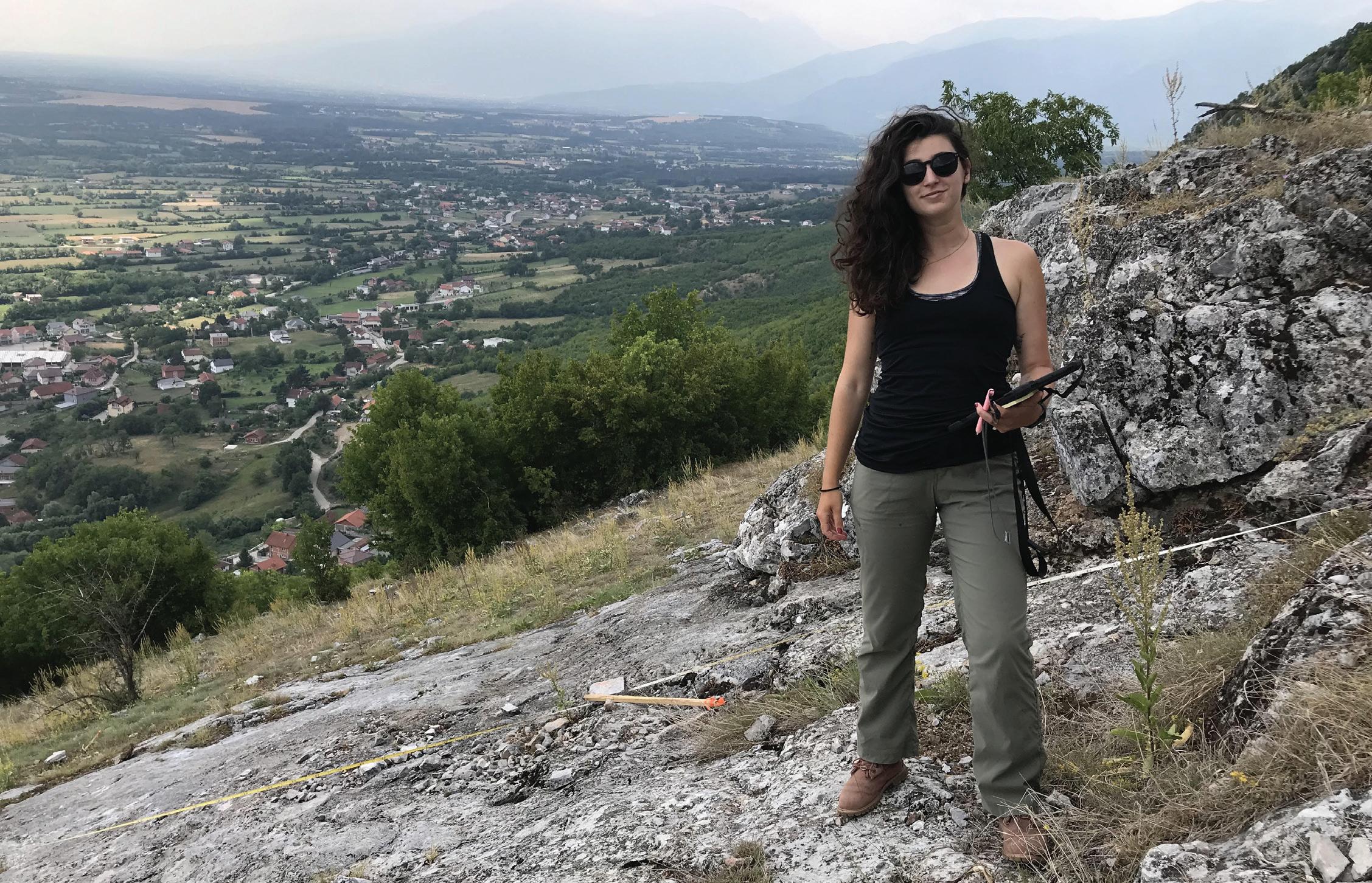

Top: Erina Baci conducted surface collections at three hillforts in the RAPID-K study area. Center left: Julian Schultz holds a Vinča-style ceramic figurine head from the site of Lluga, Kosova. Center right: Julian holds the distal end of an aurochs' radius from the site of Maliq, a large prehistoric site in Albania. Lower left: Zhaneta Gjyshja at the Late Neolithic village site of Lluga, discovered during the RAPID-K project in Kosova.
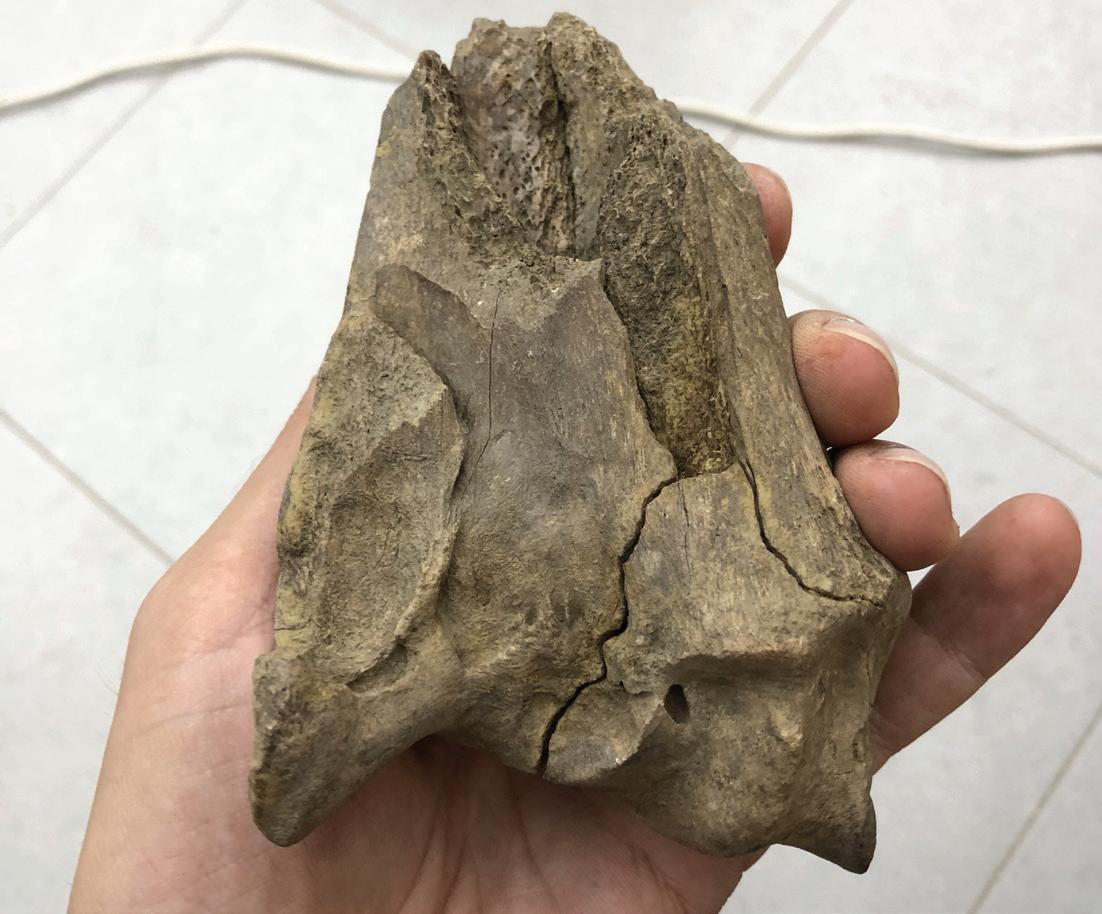


French and American students work at the archaeological site of Incoronata (1000-600 BC), in southern Italy, 2021.
Erina Baci’s dissertation project as a crew member. Her team assisted with magnetic gradiometry at multiple sites and she conducted a 5x5 m gridded surface collection at a multi-period site named Lluga. At Lluga, she collected artifacts, including chipped stone, ceramic fragments, daub, animal bones, stone axes, and a Vinča figurine head. The high density of chert tools indicates that it was a lithic workshop. It was occupied at least from the Late Neolithic into the Bronze Age. The magnetic gradiometry suggests longhouses, multiple anthropogenic features, and a potential enclosure. The site will be the focus of Zhaneta’s dissertation.
Julian Schultz participated in two projects in summer 2021: Michael Galaty’s RAPID-K survey project in Kosova, and Julian’s own faunal analysis project, the Neolithic Albanian Archaeofaunal Analysis Project, in Albania. Julian completed crucial pilot work for his dissertation research, which he will begin next summer.
In June 2021, UMMAA research affiliate Giulia Saltini Semerari organized and vice-directed the field school at Incoronata (southern Italy), under the overall scientific direction of Prof. Mario Denti of the University of Rennes 2. With a complex stratigraphic sequence spanning the tenth to the sixth centuries BC, Incoronata served as a cult and artisanal center for local communities until the seventh century, when they were joined by a group of migrants from the Aegean. Part of the broader process known as Greek colonization, the site became a key point of culture contact and negotiation at a moment of profound change towards increasing social complexity in the ancient Mediterranean. Previous work at the site uncovered substantial evidence of intentional obliteration and ritual activities prior to the abandonment of the site. This year, Giulia et al. uncovered the earliest contact phases, which were associated with a monumental wall.
While the Incoronata project has long operated as a field school for French students, this was the first year that American students were included (after quarantining in the Italian countryside!) thanks to a collaboration with the Institute for Field Research.
News from the Field 2021 Latin America

In 2021, archaeology graduate students Weston Wardle, Jennifer Larios, and Soren Frykholm excavated on the North Platform of Monte Albán in Oaxaca.
Graduate student Matthew Brown typically works in Cusco, Peru, but due to COVID-19 he was unable to return there in 2021. Instead, he assisted Museum director Michael Galaty in Kosova. Matthew also joined fellow graduate student Weston Wardle to conduct site visits in Oaxaca, Mexico. Matthew hopes to utilize the methods and knowledge he gained from the diverse field experiences in Kosova and Mexico when he returns to Cusco in January 2022. At that time, he will begin visiting sites and collecting preliminary data for his own dissertation.
During the winter and spring of 2021, Weston Wardle excavated at Monte Albán in Oaxaca as part of a conservation project. During the summer Weston visited more than a dozen communities and several archaeological sites throughout the Valley of Oaxaca that he is considering for his dissertation project. His project aims to explore what daily life was like in a small defensible village during and after the collapse of Monte Albán. Weston spent the fall semester teaching in Ann Arbor and has returned to Oaxaca to continue his research.
Soren Frykholm also went to Oaxaca to excavate. From February to May 2021, he excavated at Monte Albán with Weston Wardle and Jennifer Larios on a project directed by Dr. Nelly Robles. They excavated and restored a building on the North Platform of Monte Albán. Soren is working on an article about the Mixtec site of San Pedro Teozacoalco, Oaxaca, where he hopes to conduct his dissertation research.
Due to the pandemic, Jennifer Larios switched her focus from Cañete, Peru, to Oaxaca. In addition to excavating at Monte Albán, she assisted Laura Bossio and Brendan Nash on their respective field projects.
While his fieldwork in Belize was once again canceled due to COVID-19, Brett Meyer was fortunate to gain access to a faunal assemblage collected by the Belize Valley Archaeological Reconnaissance (BVAR) project.

Above: Matthew Brown surface collects by grid in Kosova. Below left: Jennifer Larios at Monte Albán in Oaxaca. Below right: Weston Wardle surveys sites in the Valley of Oaxaca.

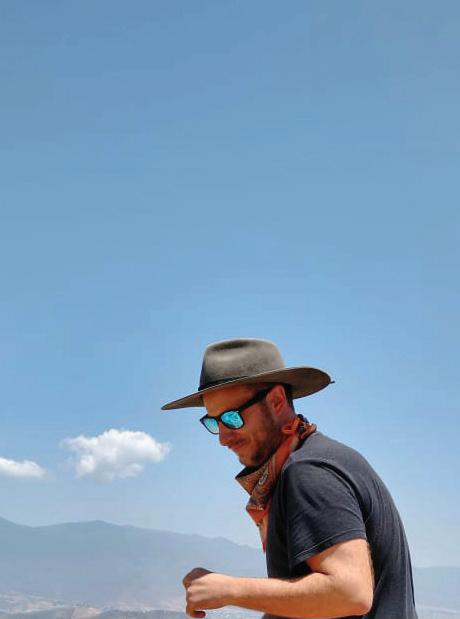

This assemblage consists of fauna from four sites—Baking Pot, Cahal Pech, Lower Dover, and Xunantunich—that span the full range of occupation in the Belize Valley from the Preclassic to the Terminal Classic. Brett’s ongoing work is to reanalyze and catalog all the fauna. In addition, he will be analyzing the new material excavated since. The results of these analyses will serve as the comparative dataset for Brett’s dissertation, which will examine how animals were used to reflect social inequality and how this inequality is manifested in non-elite households.
Curator Raven Garvey was fortunate to have a 2020 field season just before her host countries’ borders were closed due to COVID. Her crew returned to a cave site in Argentina, Cueva Yagui, excavations at which are proving critical to an understanding of the region. The photo above is from that project. Among other things, the team had to document a roof collapse that happened since their 2017 work at the site.
Garvey applied for and was granted new permits to (1) attempt a new survey method in Chilean valleys and (2) begin survey in a previously unstudied part of Neuquén Province. In addition, she is working with students Lauren Pratt, Laura Bossio, and Ian Beggen, plus undergrad Kaitlyn Poe (through UROP), and a graduate student at the University of Colorado Boulder, Collin Power, on publications related to hunter-gatherer distributions.
Garvey’s own book, Patagonian Prehistory: Human Ecology and Cultural Evolution in the Land of Giants, was released this year. Find it at uofupress.lib.utah.edu/ patagonian-prehistory and on Amazon.
Above: Raven Garvey at Cueva Yagui in Argentina. Below: Garvey’s book, Patagonian Prehistory, was published in 2021 by the University of Utah Press..

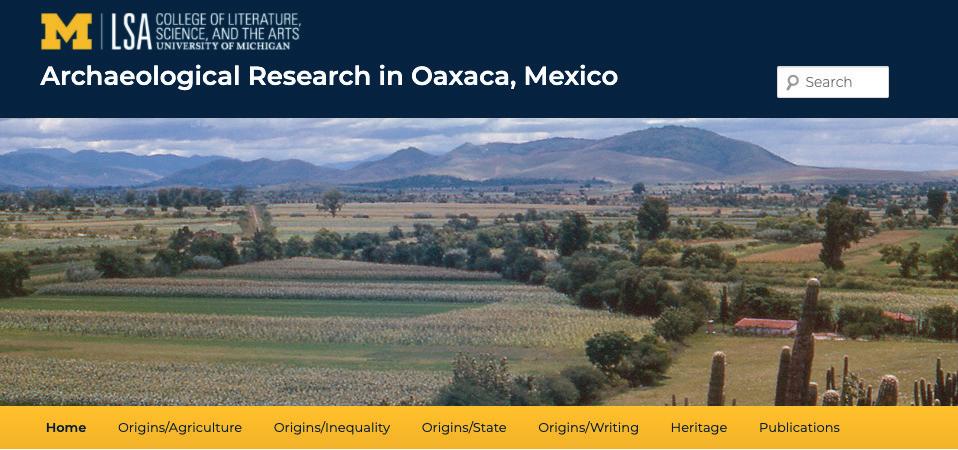
To feature the Museum’s excavations in Oaxaca, Mexico, and the 18 volumes they have so far produced, curators Kent Flannery and Joyce Marcus collaborated with PhD candidate Györgyi Parditka to generate a new website (https://sites. lsa.umich.edu/oaxaca-archaeology/). Although some of the 18 volumes had been sold out, all are now available again.
The Valley of Oaxaca was chosen for excavation because it is a laboratory for the study of the origins of agriculture, the origins of village life, the emergence of hereditary inequality, the origins of the state, and the origins of hieroglyphic writing.
Many UMMAA students, both graduate and undergraduate, have participated in the Oaxaca project. Some used Oaxaca data to write undergraduate theses, while others excavated Oaxaca sites for their PhD dissertations.
Györgyi Parditka also collaborated with Joyce Marcus in generating a new website. This second website (https:// sites.lsa.umich.edu/peru-archaeology/) features UMMAA’s excavations at Cerro Azul in the Cañete Valley of Peru, directed by Marcus. Ethnohistoric documents reveal that these coastal valleys were characterized by specialized fishing and farming communities when the Spaniards arrived in the sixteenth century. One of the goals of Marcus’ project was to determine when such community specialization began. Her excavations showed that Cerro Azul had been a specialized fishing community long before the Inca conquered the area in AD 1470. As far back as AD 1000, Cerro Azul’s fishermen dried and stored vast quantities of small fish in sand-filled rooms, ensuring that those fish would be ready to export to farming communities in the same kingdom and beyond.
Check out these two new websites to learn more about the University of Michigan’s excavations in Peru and Mexico.
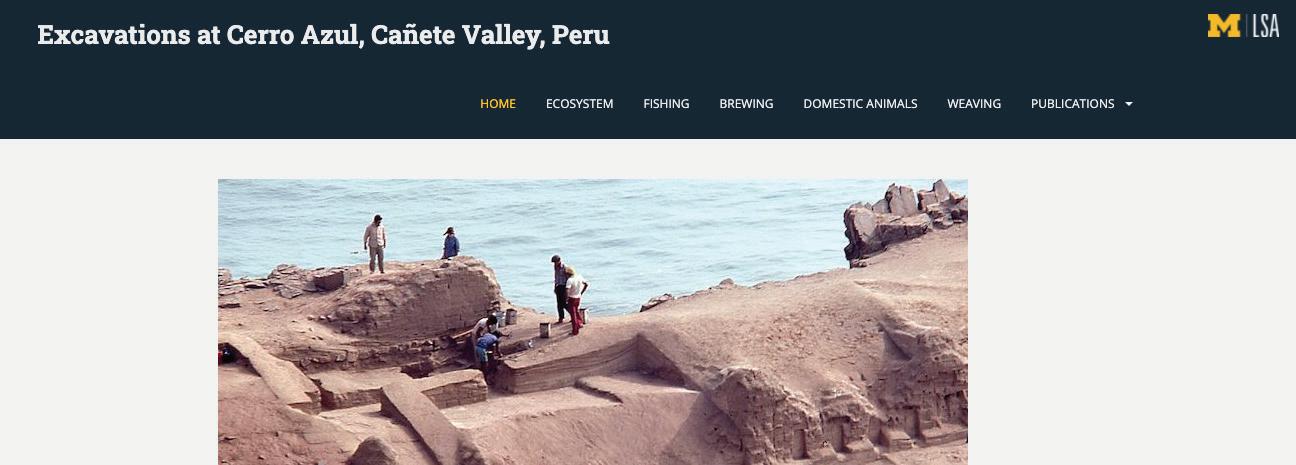
North America
In April and May of 2021, doctoral candidate Laura Bossio began fieldwork at the Williams Site (33-WO7a) in Perrysburg, Ohio. She conducted intensive and controlled surface survey at the property (the Buttonwood field) to address questions about Late Archaic and Early Woodland settlement patterns. She found a high density of artifacts during the survey, much of which seems to be related to significant and previously unknown settlements from the Late Woodland and Late Prehistoric periods. She is currently working on cataloging this collection and beginning analysis in the Research Museums Center (RMC). She is very excited to return to the field (which is now full of very healthy soybeans!) to conduct geophysical survey and to extend the very informative surface survey to learn more about these significant settlements.
This summer, graduate student Elspeth Geiger enjoyed teaching a course she designed. This class was called “How to Make Friends and Influence People: An Archaeological Guide.” During the process, she was able to use some of UMMAA’s collections for distance learning. She is currently writing her dissertation on French fur trade dynamics in Michigan.
Graduate student Hannah Hoover conducted a pilot season for her dissertation on the Mackay Point Plantation in South Carolina’s Lowcountry. She was joined by three U-M undergraduate students—Isabel Matias, Theodora Bilich, and Eloise Janssen—and archaeology graduate student Megan Savoy. Hannah excavated more than 500 shovel tests to define the boundaries of the site Pocotaligo, an eighteenth-century primary town of the Yamasee, as well as the location of the 1715 outbreak of the Yamasee War. This war was a pan-tribal conflict against the British that vastly reconfigured the Colonial landscape of the Southeast U.S. Summer 2021 excavations were the first of a multiseason and collaborative project that seeks to understand the political and social dynamics of Yamasee towns and their evolving relations with the British during a twentyyear period leading up to the war. Hannah’s fieldwork this season was funded by the Lewis & Clark Research and Exploration Fund, UMMAA, and the U-M Department of Anthropology.
Although unable to travel to the Near East due to Covid restrictions, graduate student Kara Larson still had a productive summer. Her summer was divided among fieldwork, lab research, grant writing, publication preparation ... and a wedding! Kara spent the month of May excavating at the Hester site, an open-air Archaic site in northeast Mississippi, with archaeologists from the

In the pilot season for her dissertation, archaeology graduate student Hannah Hoover dug more than 500 shovel tests at the Pocotaligo site in South Carolina.
University of Georgia and Mississippi State University. Following fieldwork, Kara worked as a team member on curator Alicia Ventresca Miller’s new collaborative project, entitled Northern Realms of the Mongol Empire, along with other faculty and graduate researchers from the University of Michigan. Kara also started her pilot isotopic project sampling and analyzing carbon, oxygen, and strontium from Early Bronze Age faunal remains at Tell





